 |
[April 2nd 2004]
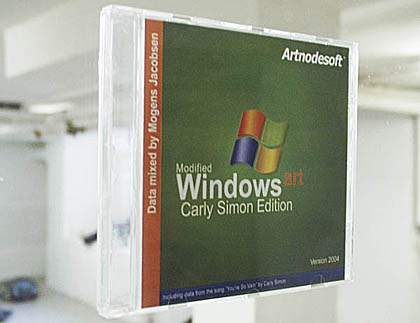
Mogens Jacobsen: Modified
Software, Carly Simon Edition
Between Software and Hardware.
Interview with Morten Schjødt,
Mogens Jacobsen and Peter Fjeldberg
The RADAR festival is currently
taking place in various locations in the city. For this occasion
Artnode is exhibiting at Galleri 24B with 'Artnode Gets Physical'.
As implied by the title the exhibition is a step away from the net
art that Artnode is usually known for, towards more physical settings.
In several of the works the interactive takes centre stage. At the
same time there are links back to the group's electronic and digital
trademarks, and so e.g. interactive film, SMS art and modified software
can be experienced at the exhibition. In the middle of the rush
to get the exhibition mounted Kopenhagen caught up with Morten Schjødt,
Mogens Jacobsen and Peter Fjeldberg from Artnode for a couple of
explanatory comments about theirworks. Interview and photo: Mads
Johannes Nielsen. Translated by Sofie Paisley.
Artnode
Artnode Gets Physical
April 1st - April 4th 2004
Galleri 24B
Vesterbrogade 24B, 1620 Cph. V
Open Thur-Sun. 5pm - 8pm
Morten Schjødt - your part of the exhibition is the film
"Switching". Can you tell us about it?
It's an interactive feature film produced with Oncotype. It's a
kind of film puzzle with pieces that you move around. When the film
starts it looks exactly like an ordinary film, but it has a completely
different narrative structure that I call a loop structure. The
story consists of circles and loops, everything repeats itself and
once you've started the film it goes on forever unless you stop
it. There's no determined ending even though you as spectator can
play around with the idea of one.
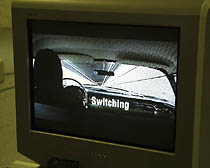 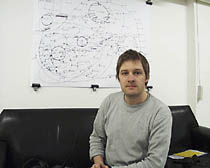
Morten Schjødt: Switching,
videostill
Morten Schjødt
What is played with in this film is the concept of how you tell
its story. As a spectator you are in a state where you both create
and destroy by clicking onwards on the remote control. It's a film
that is at the same time, falling apart and being created. It's
completely up to the user how they move around in it. The film thus
also lacks any set length. It's expansible as it can last anywhere
from 4 minutes to 2 hours.
The film simply cannot run chronologically, it constantly runs in
its circular system. If you don't click onwards it will repeat itself.
The film's plot centres on a couple that have become stuck in relation
to each other. They are at a turning point where they are trying
to figure out if the magic between them has disappeared, or if they
can start over. Their dilemma is that they can't communicate. This
is why they are forced to repeat the pattern of the vicious circle
- unless the spectator clicks! If the spectator does that the story
expands, although there is always the risk of becoming stuck again.
In this way a scene you perceive as reality at the start, can be
experienced as a fantasy when seeing it twenty minutes later. The
question for the spectator becomes "should I click onwards
or not?". There are no interface or buttons on the screen to
tell you when to click onwards. You have to learn to read this even
if you, in principle, can do it all the time.
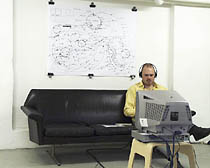 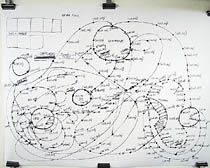
Jacob Lillemose watches
Switching
Morten Schjødt: Switching, flowchart
The special thing about this exhibition is that along with the
film, I have also exhibited its flowchart. The chart functions as
a map of roads to be taken in the film, and gives the work as a
whole a physical dimension. I place the chart on the paper alongside
the digital film so that you suddenly see both things. In comparison
to Artnode that usually deals with the Internet, this project is
different, as it can't really be exhibited as a whole on the net.
That is why it has instead been published as a DVD.
Mogens Jacobsen - you have made something called
"Modified software". What is it?
It's theoretical software, which is software that cannot run on any
machine. It's a mixture between Microsoft's Windows XP Home edition
and popular songs. I've used a binary editor where I've changed the
individual bits using the copy/paste function and thereby moved parts
from an mp3 file, with e.g. David Bowie, and have then inserted them
into the files making up the installation program for Windows XP.
Each of the three compact discs contains a mixture of data from the
operational system and a song. There is a Carly Simon edition, a David
Bowie edition and a Carpenters edition of Microsoft's Windows XP.
Of course, none of them can be played as music on any DVD or CD player.
A computer can read that there's a file but if you attempt to run
it, it stops. The program no longer works because it's a mutated code.
All along I've felt like mixing an operational system with Carly Simon's
"You're so vain", I don't really know why. From that, it
was obvious that a joke had to be made about the act of using Microsoft
software, and "The Man Who Sold The World" by David Bowie
was chosen. In relation to Microsoft's urge to control everything
"Close to you" by the Carpenters was an obvious choice.
In relation to time and mood it also fits nicely with the rest of
the music.
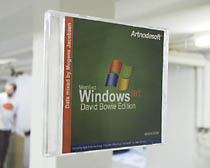 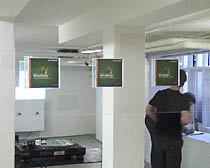
Mogens Jacobsen: Modified Software, David Bowie Edition
Mogens Jacobsen: Modified Software
You also exhibit another work?
The next thing I've made is a record player. Vega is very involved
in RADAR so it's easy to borrow a real DJ record player. I've always
been fascinated by record players and have made many interactive
virtual things about records. So, now at last I've made a physical
record player. I was fully aware that I didn't want to make anything
with sound, seeing as it was a record player, so I made one with
lights instead. It consists of a record, there's a mirror, and the
pickup no longer 'reads' but alternatively now writes down. It contains
two powerful light diodes flashing down on the record as it spins.
What I like a lot about record players is that they jump or "skip"
when you walk around them. This is why I have connected a large
bass loudspeaker, which is based on the vibrations in the floor
around it. When the spectator moves around it (or gives it a push)
the light diodes in the pickup react, which is an interactive element.
The record player reads the same error as a normal record player
would, but the output is light reflections instead of sound.
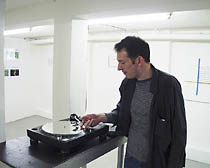 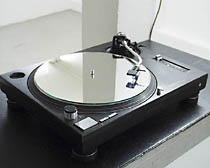
Mogens Jacobsen
Mogens Jacobsen: SKIP
Peter Fjeldberg - You exhibit 'Roombox'. What is it?
It's a sound box or a rhythm box you control by moving in front
of three microphones with a small loudspeaker. The microphones calculate
where the sound comes from, and depending on where, different sounds
will come out of the rhythm box. It's a new project that I haven't
really finished yet, and don't think I ever will as it is difficult
to calculate where the sound is. Especially when there are several
people in the room and the background noise grows.
 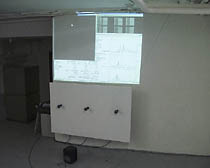
Peter Fjeldberg
Peter Fjeldberg: Roombox
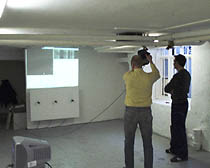 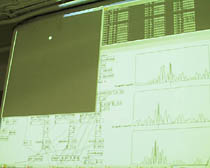
Jacob Lillemose og Mogens Jacobsen in
Roombox
Peter Fjeldberg: Detail from Roombox
The idea behind it is that computer based instruments are never
really comprehensible as the more analogue ones, because there is
no interface. You sit still, nerding and messing around with the
virtual buttons on the screen, completely different from any other
instrument. I want the instrument to come out into the room so you
can do something with you body, and move. At the same time it is
to be seen as an alternative interface for the computer. You can
compare the sound box to a giant mouse where the user is the mouse
itself, and has to run around to control the cursor on the screen.
On the secondary level you simultaneously get the sound, which changes,
and the music should hopefully inspire the user to move and thus
create new sounds. My earlier experiments at home have shown that
you can easily use a couple of hours playing with it. In comparison
to the other works in the exhibition, this one is not as physically
concrete. In a way you can say that it hasn't gotten out of the
computer, but it's on its way. Seen the other way around, it can
also be interpreted as if the spectator is entering the computer
…
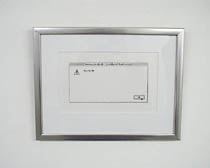 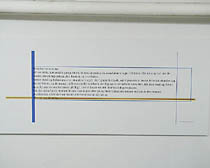
Kim Borreby: OK
Martin Pingel: Stranden var sort her
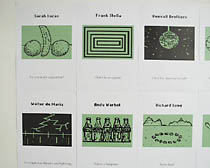 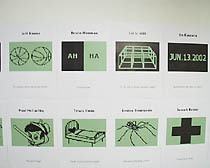
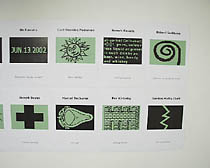
Jacob Lillemose og Nikolaj Recke:
Picture Messages
More about Artnode:
www.artnode.org
30. marts 2004:The Net Wants to Be
Free - The Saga Continues
10.
oktober 2002: Interview med Mogens Jacobsen
|
 |
|